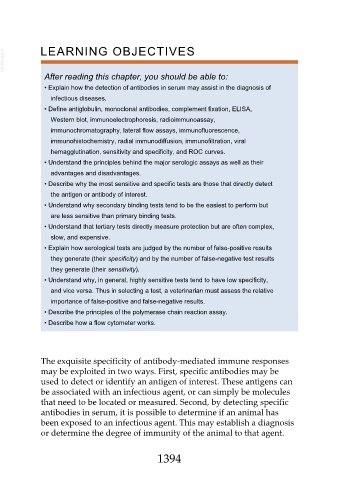Page 1394 - Veterinary Immunology, 10th Edition
P. 1394
VetBooks.ir LEARNING OBJECTIVES
After reading this chapter, you should be able to:
• Explain how the detection of antibodies in serum may assist in the diagnosis of
infectious diseases.
• Define antiglobulin, monoclonal antibodies, complement fixation, ELISA,
Western blot, immunoelectrophoresis, radioimmunoassay,
immunochromatography, lateral flow assays, immunofluorescence,
immunohistochemistry, radial immunodiffusion, immunofiltration, viral
hemagglutination, sensitivity and specificity, and ROC curves.
• Understand the principles behind the major serologic assays as well as their
advantages and disadvantages.
• Describe why the most sensitive and specific tests are those that directly detect
the antigen or antibody of interest.
• Understand why secondary binding tests tend to be the easiest to perform but
are less sensitive than primary binding tests.
• Understand that tertiary tests directly measure protection but are often complex,
slow, and expensive.
• Explain how serological tests are judged by the number of false-positive results
they generate (their specificity) and by the number of false-negative test results
they generate (their sensitivity).
• Understand why, in general, highly sensitive tests tend to have low specificity,
and vice versa. Thus in selecting a test, a veterinarian must assess the relative
importance of false-positive and false-negative results.
• Describe the principles of the polymerase chain reaction assay.
• Describe how a flow cytometer works.
The exquisite specificity of antibody-mediated immune responses
may be exploited in two ways. First, specific antibodies may be
used to detect or identify an antigen of interest. These antigens can
be associated with an infectious agent, or can simply be molecules
that need to be located or measured. Second, by detecting specific
antibodies in serum, it is possible to determine if an animal has
been exposed to an infectious agent. This may establish a diagnosis
or determine the degree of immunity of the animal to that agent.
1394

